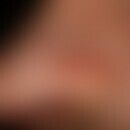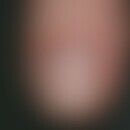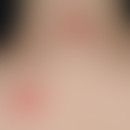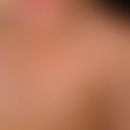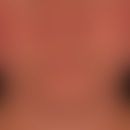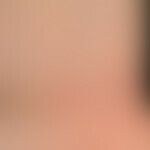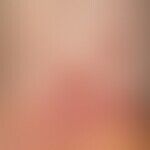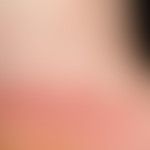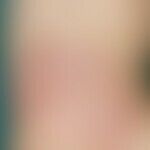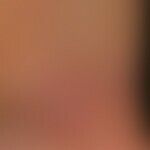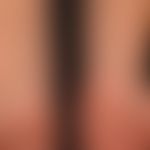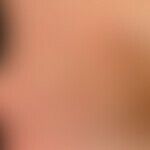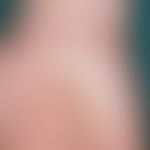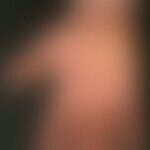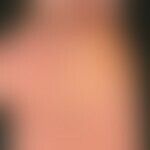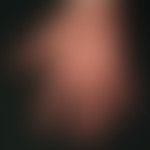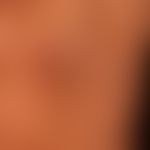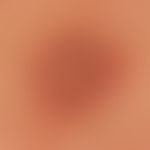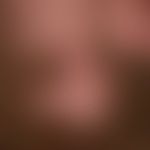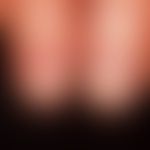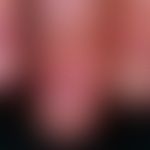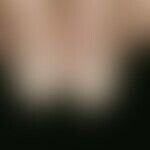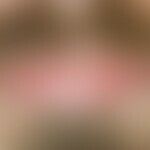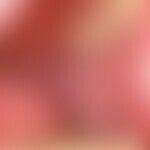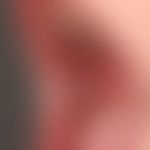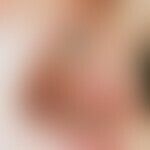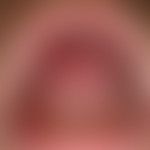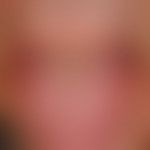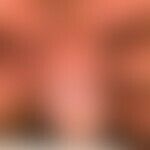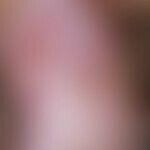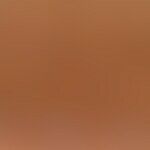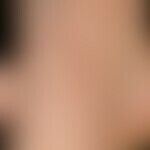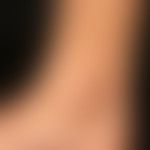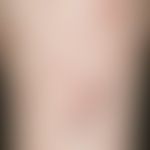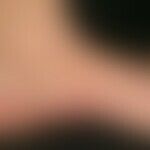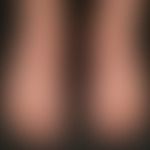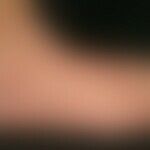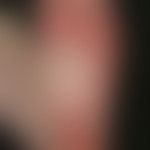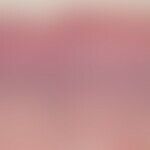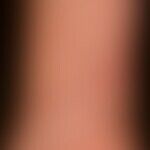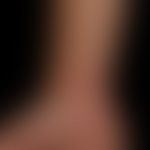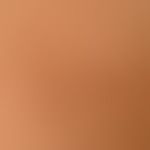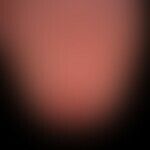Synonym(s)
HistoryThis section has been translated automatically.
Erasmus Wilson, 1869
DefinitionThis section has been translated automatically.
Non-contagious, subacute to chronic, markedly pruritic, usually self-limited (duration of disease between 1 month and 10 years), inflammatory disease of the skin and/or mucous membranes covered with squamous epithelium (intestinal mucosa and mucous membranes of the urogenital tract remain uninvolved) of unknown etiology, with typical clinical (papules shining on the skin as if polished) and histological morphology (destruction of basal keratinocytes by cytotoxic T cells) and a characteristic distribution pattern often accentuated on the flexor side.
Lichen planus is characterized by a characteristic "lichenoid tissue reaction", which can also occur in other inflammatory processes of the skin (e.g. in lichenoid drug reactions, in a "graft-versus-host reaction" in initial lichen sclerosus et atrophicus, in erythema dyschromicum perstans).
You might also be interested in
Occurrence/EpidemiologyThis section has been translated automatically.
Prevalence: 0.2%-5.0% of the (adult) population with differences in the respective subtypes. The estimated incidence of LP in the general population is between 0.1% and 1.27%. Based on 100,000 people, the overall prevalence is 90.3 and the overall incidence is 20.6/100,000 (Schruf E et al. 2022).
In contrast, a very low prevalence and incidence were observed in adolescents and children.
Up to 25% of patients have isolated lichen planus of the mucosa.
Familial lichen planus is rare (about 100 cases are known). Earlier age of manifestation than in non-familial LP.
EtiopathogenesisThis section has been translated automatically.
Autoimmune reaction: To date, the etiology and pathogenesis of lichen ruber is not fully understood. There are correlations with autoimmune diseases, viral infections, medications and mechanical trigger factors (scratching, rubbing, etc.). LP-like lesions occur in chronic graft-versus-host disease (GVHD ), in which alloreactive, cytotoxic T cells and antibodies that recognize foreign MHC molecules are decisive effectors. The morphological analogy of the dermatitic reactions leads to the hypothesis that in lichen planus there is an autoimmune reaction against epitopes of basal keratinocytes that have been modified by viral or drug induction. It is undisputed that the apoptotic destruction of basal keratinocytes is the common final stage of the lichen planus reaction (this certainly also plays an important role in other autoimmune skin diseases, e.g. LE). Ligand-receptor-dependent dysregulation(TNF-alpha/TNFR1= TNF-alpha receptor) is discussed as the cause. The direct "pore formation" by perforin and the subsequent enzymatic degradation by serine proteases (see Granzyme B below), which is known to occur during apoptosis, is also discussed.
Remarkable findings in idiopathic lichen planus indicate that the expression of PD-1 and its ligand PD-L1 is reduced on infiltrating inflammatory cells, predominantly on lymphocytes (Shirouchi K et al. 2021)
In early changes, the significant proliferation of antigen-presenting cells (APCs) is noticeable. These are possibly induced by the keratinocytes themselves through dysregulation of cytokine production.
Viral antigens appear to play a preferential role in the aetiopathogenesis of lichen planus. The prevalence of HCV/HBV infections (hepatitis C/B) is 13.5 times higher in lichen planus than in controls. In oral lichen planus, a high percentage of HCV RNA and TTV DNA (transfusion-transmitted virus) was detected in lesional mucosa. The occurrence of lichen ruber after HBV vaccine has been described. The etiopathogenetic significance of HHV-7/HHV-8 cannot be clearly proven. Noteworthy are reports of the occurrence of lichen planus after SARS-CoV-2 vaccination (Zengarini C et al. 2022). The same can be reported for erythema multiforme
Drugs: Lichen ruber as ADR after therapy with monoclonal antibodies against programmed cell death 1 (anti-PD-1 - e.g. nivolumab): These ADRs include both classic lichen ruber and, in rarer cases, pemphigoid lichen ruber. Naproxen is known to be another lichen planus inducer (Güneş AT et al. 2006).
Diabetes mellitus: An association of lichen ruber and diabetes mellitus is strikingly frequent. Every 2nd patient has a disorder of glucose metabolism and every 4th has manifest diabetes mellitus.
Contact allergens: The role of contact allergies to a number of metal salts (gold, amalgam, copper) is well known in oral lichen ruber. It is discussed that these antigens can trigger an LP reaction in the manner of haptens.
Paraneoplasia: There are isolated reports of paraneoplastic lichen ruber.
Familial occurrence: About 100 cases of familial lichen planus have been reported so far. There is no significant relationship to specific HLA types.
ManifestationThis section has been translated automatically.
Preferably occurring in adults in the 3rd to 6th decade of life. Rare in children (about 1-4% of cases).
No ethnic predisposition. Women seem to be affected slightly more often than men (see also Lichen planus mucosae).
LocalizationThis section has been translated automatically.
Affected are:
Flexor side of the wrists and forearms, lateral ankle area of the ankles
Mucosal infestation (30-40%): penis, oral and genital mucosa, esophageal mucosa)
Nails (10%)
Capillitium (see also Graham-Little syndrome).
Generalized or universal (erythrodermic) occurrence is possible (see also Lichen planus exanthematicus)
ClinicThis section has been translated automatically.
Initially about 0.1 cm in size, surrounded by the natural skin furrows, raised, plateau-like, smooth, shiny like lacquer (surface smooth as if polished), clearly itchy, red papules. Aggregation of several papules with formation of plaques of different sizes. Small lamellar scaling is rarely visible.
The diagnostically important surface reflection of the lichen planus papules is best recognized when light falls on it from the side. Wickham's pattern and the linear arrangement of the efflorescences in scratching or rubbing marks are also typical (see Köbner phenomenon [= isomorphic stimulus effect] below). The lesional itching is responded to by the patient by rubbing ( shiny nails are often detectable); excoriations rarely occur (this means that fresh or older scratch erosions such as those to be expected in atopic dermatitis are absent).
Localized, rough, yellow-reddish, hyperkeratotic plaques appear on the palms and soles, including the lateral edges, with a red border at the edges.
A varying degree of oral mucosal infestation (see also Lichen planus mucosae) is observed in > 50% of patients. Typical are symmetrical, reticular or nummular white plaques, also disseminated, 0.1 cm large white papules of the buccal mucosa and/or the tongue and/or the gingiva. A special feature is the painful and therapy-resistant erosive lichen planus of the oral mucosa.
Genitalia, especially the glans penis and vulva, are often affected in the form of anular or circinate, whitish but also red or erosive plaques (see below Lichen ruber mucosae/ Lichen planus vulvae).
Capillitium (see below Lichen ruber follicularis capillitii).
Nails: Frequently thinned and shortened ("starvation halfway") nails, frequently frayed nail plates with longitudinal distortions of the surface and numerous spots. Pterygia possible. Rarely colorless or red longitudinal striations(erythronychia). Complete destruction of the nail plate is possible. It is not uncommon to find shiny nails (consequence of permanent chafing).
LaboratoryThis section has been translated automatically.
No pioneering laboratory parameters!
HistologyThis section has been translated automatically.
Uniform and pathognomic histologic pattern of a classic interface dermatitis with irregular, often sawtooth-like acanthosis, compact orthohyperkeratosis with prominent hypergranulosis (circumscribed thickening of the keratohyalin-containing cell layers of the stratum granulosum causes the clinical picture of Wickham's pattern). Usually very prominent, dense, band-shaped, lymphoid cellular, epidermotropic infiltrate. The inflammatory infiltrate consists predominantly of oligoclonal, CD8-positive, cytotoxic T cells. Focal pigment incontinence. Vacuolar degeneration of the basal epithelial cell layers, resulting in clefts (Max Joseph's spaces) and even subepithelial blistering (lichen planus bullosus). Detection of numerous cytoid bodies (Civatte bodies or cytoid bodies (colloid bodies), see below. apoptosis). Epidermal Langerhans cells are increased in active lesions. Plasma cells, neutrophil and eosinophil leukocytes may be present, but are not common.
Direct ImmunofluorescenceThis section has been translated automatically.
Typical, strong, band-shaped subepithelial fibrin deposits. Clear spherical fluorescence phenomena due to the detection of several immunoglobulins, especially IgM, complement or fibrinogen, in connection with apoptotic keratinocytes (Civatte bodies). Linear immunoglobulin ablations are rare. The DIF with a sensitivity of 75 % is particularly helpful in differentiating between erosive LP and immunobullous diseases such as pemphigus vulgaris.
Differential diagnosisThis section has been translated automatically.
- Clinical differential diagnoses:
- Integument:
- Psoriasis punctata: The Auspitz phenomenon is always detectable and always absent in lichen planus!
- Lichenoid medicinal exanthema: History; usually no involvement of the oral mucosa.
- Pityriasis lichenoides et varioliformis acuta: As in "Heubner's star chart" very polymorphous, pruritic or also burning exanthema, with papules, erosions, ulcers and possibly hemorrhagic vesicles. Lichen planus exanthema is monomorphic.
- Papular syphilid: Clinically, the lichenoid character of the single-cell lesions is absent; pruritus is mild or absent.
- Scabies: Multiple erythematous papules on the wrists may complicate the differential diagnosis of scabies and lichen ruber.
- Oral mucosa:
- Leukoplakia: In the area of the oral mucosa, leukoplakia or mechanical mucosal irritations have to be differentiated. Histological clarification is necessary. In both cases the typical "anular structures" of the LP are missing.
- Candidiasis of the oral mucosa: Infestation of the tongue, cheek mucosa and soft and hard palate with white to grey-white plaques that can be easily wiped off (LP cannot be wiped off!).
- Gingivitis marginalis: similar, therapy-resistant pattern with analogous symptoms. Histological clarification is necessary.
- Integument:
- Histological differential diagnoses:
- Lichenoid medicinal exanthema: Largely identical picture, apoptotic keratinocytes are frequent, possibly focal parakeratosis, which is always absent in lichen planus. Marked histoeosinophilia is possible as well as a plasma cell infiltrate component.
- Fixed drug reaction: Numerous apoptotic keratinocytes, perivascular infiltrate thickening, often marked eosinophilia, prominent pigment incontinence.
- Lichensclerosus et atrophicus: Initial lichenoid infiltrate without 3-zone phenomenon. Pattern analogous to lichen planus; later typical zonal pattern.
- Acute graft-versus-host disease: Numerous apoptotic keratinocytes, strong vacuolization of the junctional zone, less dense infiltrate.
- Papular syphilid: Epidermis with psoriasiform acanthosis and focal spongiosis; admixture of neutrophilic granulocytes and (numerous) plasma cells.
Complication(s)(associated diseasesThis section has been translated automatically.
There is a certain (unspecified) risk of developing epithelial tumors (spinocellular carcinomas) in long-term persistent LP lesions of the skin and mucous membranes. The risk of malignant changes in the lip or oral mucosa is 7 times higher in LP patients.
The diagnoses of alopecia areata and vitiligo are also significantly more common in LP patients than in control collectives (Schruf E et al. 2022).
In larger collectives, dyslipidemia and autoimmune thyroiditis occur more frequently than in a control group ( Schruf E et al. 2021).
General therapyThis section has been translated automatically.
The therapy depends on an identifiable cause (e.g. medication such as antihypertensives, NSAIDs), the clinical aspect (localized/generalized) and the previous course (acute/chronic). In many cases, the treatment of itching is the main focus.
External therapyThis section has been translated automatically.
Glucocorticoids (currently parkatized first-line standard): For circumscribed asymptomatic findings, medium-strength glucocorticoids such as 0.25% prednicarbate (e.g. Dermatop® cream), 0.1% mometasone furoate (e.g. Ecural® fat cream), in persistent cases also strong 0.05% glucocorticoids such as clobetasol (e.g. Dermoxin® cream), if necessary also under occlusion (2 times/day 2-4 hours).
If necessary, inject the foci with glucocorticoid crystal suspension such as triamcinolone acetonide (e.g. Volon® A) 10-40 mg with 2-4 ml 1% mepivacaine in a syringe and apply intrafocally.
Calcineurin inhibitors: Tacrolimus or Pimecrolimus can be used topically as off-label use. Both substances are particularly effective in cases of mucosal infestation. However, due to the unknown long-term effects of calcineurin inhibitors and the carcinogenicity of pimecrolimus proven in animal experiments, the indication for treatment with calcineurin inhibitors must be extremely strict!
Radiation therapyThis section has been translated automatically.
PUVA: For extensive, especially disseminated forms, PUVA bath therapy, a re-PUVA therapy (PUVA + Acitretin) or a systemic PUVA therapy are suitable. Success is shown in approx. 80-90% of cases.
Internal therapyThis section has been translated automatically.
Acitretin: In the case of extensive infestation, start treatment with acitretin (neotigason) initially 0.5 mg/kg bw/day, maintenance dose 0.1-0.2 mg/kg bw/day according to the clinic. Systemic retinoids achieve the highest levels of evidence in studies (Schilling L et al. 2018). Discontinuation trial after 1/2 year at the earliest.
Alternatively or in severe cases: acitretin in combination with glucocorticoids such as prednisolone (e.g. Decortin H) initially 0.5 mg/kg bw/day, tapering over a period of 4-6 weeks. Maintenance dose according to clinic with 5-10 mg/day.
Alternatively: Other systemic therapeutic agents that have been described in various smaller studies can be regarded as "third line" therapy for therapy-resistant lichen planus of the external integument. These include: Ciclosporin A, griseofulvin, oral metronidazole, sulfasalazine, mycophenolate mofetil, azathioprine, thalidomide.
Alternative, experimental: Apremilast, an oral thalidomide analog that has been successfully tested in a small monocentric study for exanthematic lichen planus.
Still in clinical trials are 1L-17A inhibitors, JAK1/2 inhibitors and OSMRbeta inhibitors.
Special issues:
- In cases of therapy-resistant lichen planus erosivus mucosae (see there), stronger local or systemic immunosuppressive measures are necessary.
- Lichen planus genitalis: Therapeutic measures see below. Lichen planus erosivus mucosae.
- Lichen planus follicularis capillitii (see there).
- Lichen planus of the nails: I.A. no special therapy, as nail changes usually occur with other LP lesions. Some US authors recommend perilesional injections with glucocorticoids(caution! painfulness). In individual cases, good therapeutic success has been reported with Ciclosporin A (initial: 2x100mg/day p.o. maintenance dose 100mg/day p.o.). Own experience exists with azathioprine (initial: 1.0-1.5mg/kgKG, maintenance dose at 0.5mg/kgKG).
- In the case of drug-induced lichen planus, the initiating medication should be discontinued. Otherwise treatment as for classic lichen planus.
Progression/forecastThis section has been translated automatically.
Classic cutaneous LP is self-limiting and usually heals within 6 (>50%) to 18 months (85%). However, chronic courses lasting for years (decades) are also possible. Mucosal changes that persist for years are to be regarded as facultative precancerous lesions!
NaturopathyThis section has been translated automatically.
Externally: Phytotherapy: Anti-itching plant ingredients with cooling effect such as: camphor, mint or peppermint oil, menthol in DAC cream as a base, capsaicin (0.02-0.075%) can be applied on intact skin! 2-3x /day can be applied.
Formulation example for a 1% menthol cream:
- Menthol1,0
- DAC base cream ad 100,0.
- S.:Apply Ambiphilic 1% Menthol Cream 2-3 times/day to itchy skin areas. Use-by date: Tube: 6 months
Systemic: Oral bromelain (e.g. Bromelain-POS) or Phlogenzym(Phlogenzym-mono) is further recommended.
Note(s)This section has been translated automatically.
Patients with lichen planus are primarily treated by dermatologists and general practitioners, followed by gynecologists and internists.
LiteratureThis section has been translated automatically.
- Brănişteanu DE et al (2014) Cutaneous manifestations associated with thyroid disease. Rev Med Chir Soc Med Nat Iasi 118: 953-958
- Butch F et al (2014) Successful therapy of lichen planus of the nails with ciclosporin. JDDG 12: 724-725
- Chiheb S et al. (2015) Clinical characteristics of nail lichen planus and follow-up: A descriptive study of 20 patients. Ann Dermatol Venereol 142:21-25
- Deen K et al. (2015) Mycophenolate mofetil in erosive genital lichen planus: A case and review of the literature. J Dermatol doi: 10.1111/1346-8138.12763
- De Vries et al. (2007) Lichen planus remission is associated with decrease of human herpes virus type 7 protein expression in plasmacytoid dendritic cells. Arch Dermatol Res 299: 213-219
- Eisman S, Orteu CH (2004) Recalcitrant erosive flexural lichen planus: successful treatment with a combination of thalidomide and 0.1% tacrolimus ointment. Clin Exp Dermatol 29: 268-270
- Frieling U et al. (2003) Treatment of severe lichen planus with mycophenolate mofetil. J Am Acad Dermatol 49: 1063-1066
- Gandolfo S et al. (2004) Risk of oral squamous cell carcinoma in 402 patients with oral lichen planus: a follow-up study in an Italian population. Oral Oncol 40: 77-83
- Güneş AT et al. (2006) Naproxen-induced lichen planus: report of 55 cases. Int J Dermatol 45:709-712.
- Harden D et al. (2003) Lichen planus associated with hepatitis C virus: no viral transcripts are found in the lichen planus, and effective therapy for hepatitis C virus does not clear lichen planus. J Am Acad Dermatol 49: 847-852
- Hodgson TA et al. (2003) Long-term efficacy and safety of topical tacrolimus in the management of ulcerative/erosive oral lichen planus. Eur J Dermatol 13: 466-470
- Kraft K (2014) Naturally against pruritus. Dermatology close to the skin 30: 42-43
- Kolb-Maurer A et al. (2003) Treatment of lichen planus pemphigoides with acitretin and pulsed corticosteroids. Dermatology 54: 268-273
- Lehman J et al (2009) Lichen planus. Int J Dermatol 46: 682-694
- Mastorino L et al. (2022) Lichen ruber planus arising during dupilumab treatment for atopic dermatitis. Ital J Dermatol Venerol 157:449-450.
- Mueller KA et al. (2021) A case of severe nivolumab-induced lichen planus pemphigoides in a child with metastatic spitzoid melanoma. Pediatr Dermatol 40: 154-156.
- Murphy MJ et al. (2021) Treatment of Persistent Erythema Multiforme With Janus Kinase Inhibition and the Role of Interferon Gamma and Interleukin 15 in Its Pathogenesis. JAMA Dermatol 157:1477-1482.
Schruf E et al. (2021) Lichen planus in Germany-epidemiology, treatment and morbidity. A retrospective analysis of health insurance data. JDDG: 1101-1111.
Shirouchi K et al. (2021) Reduced expression of programmed cell death 1 and programmed cell death ligand 1 in infiltrating inflammatory cells of lichen planus without administration of immune checkpoint inhibitors. J Dermatol 48:1428-1432.
Wilson E (1869) On lichen planus. J Cutan Med 8: 117
- Wolf R et al. (2010) Pleomorphism of lichen ruber - clinical variation, pathogenesis and therapy. Act Dermatol 36: 180-185
- Zengarini C et al. (2022) Lichen ruber planus occurring after SARS-CoV-2 vaccination. Dermatol Ther 35:e15389.
Incoming links (96)
Acanthosis; Acitretin; Acrokeratosis verruciformis; Alterserythrodermia; Anal carcinoma; Anal fissure; Angiohistiocytoma with giant cells; Apoptosis; Apremilast; Autoimmune diseases; ... Show allOutgoing links (61)
Acitretin; Alopecia areata (overview); Apoptosis; Apremilast; Atopic dermatitis (overview); Azathioprine; Calcineurin inhibitors; Candidiasis of the oral mucosa; Ciclosporin a; Drug exanthema lichenoid; ... Show allDisclaimer
Please ask your physician for a reliable diagnosis. This website is only meant as a reference.
Images (40)
Articlecontent
- History
- Definition
- Occurrence/Epidemiology
- Etiopathogenesis
- Manifestation
- Localization
- Clinic
- Laboratory
- Histology
- Direct Immunofluorescence
- Differential diagnosis
- Complication(s)(associated diseases
- General therapy
- External therapy
- Radiation therapy
- Internal therapy
- Progression/forecast
- Naturopathy
- Note(s)
- Literature
- References
- Authors
